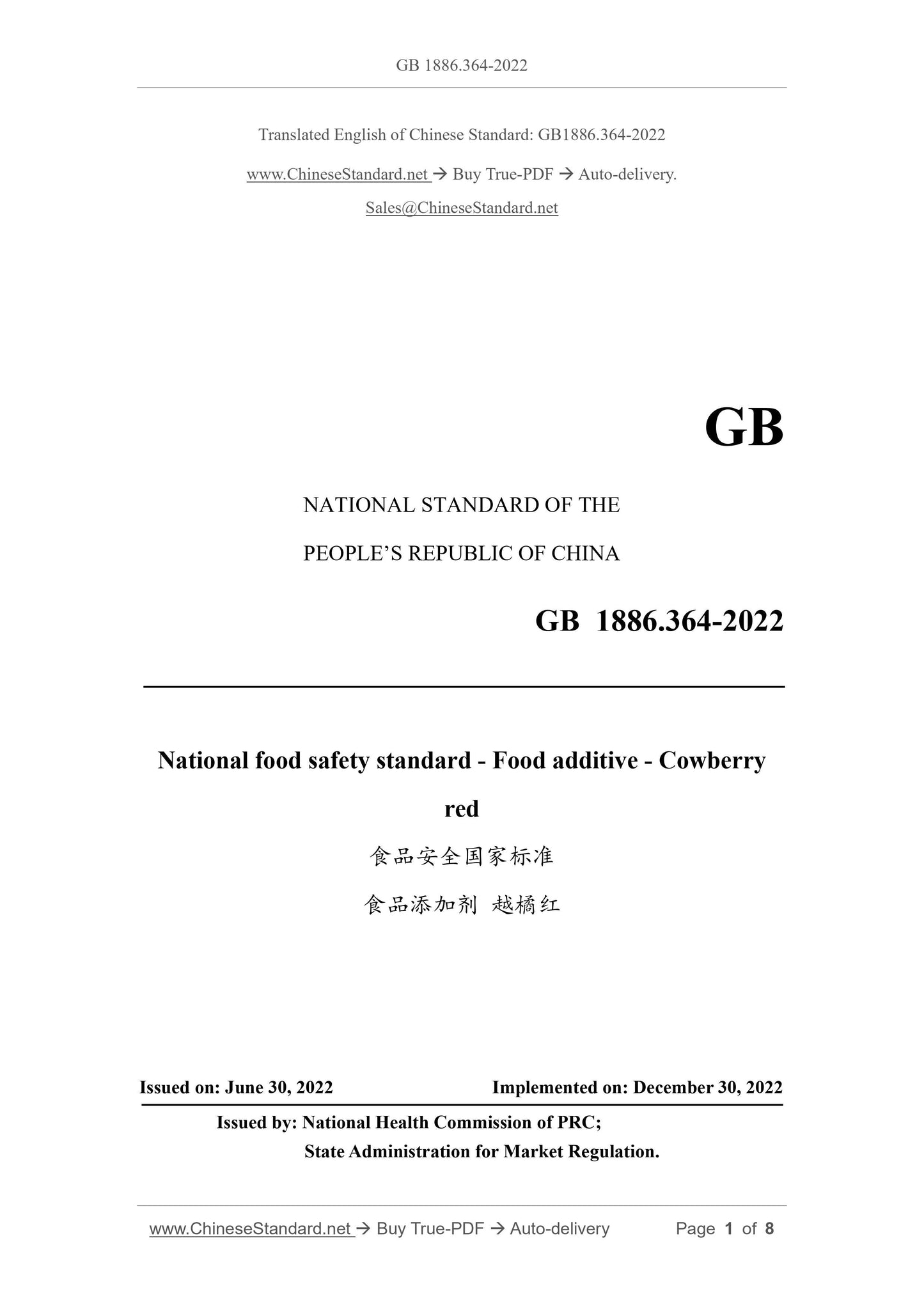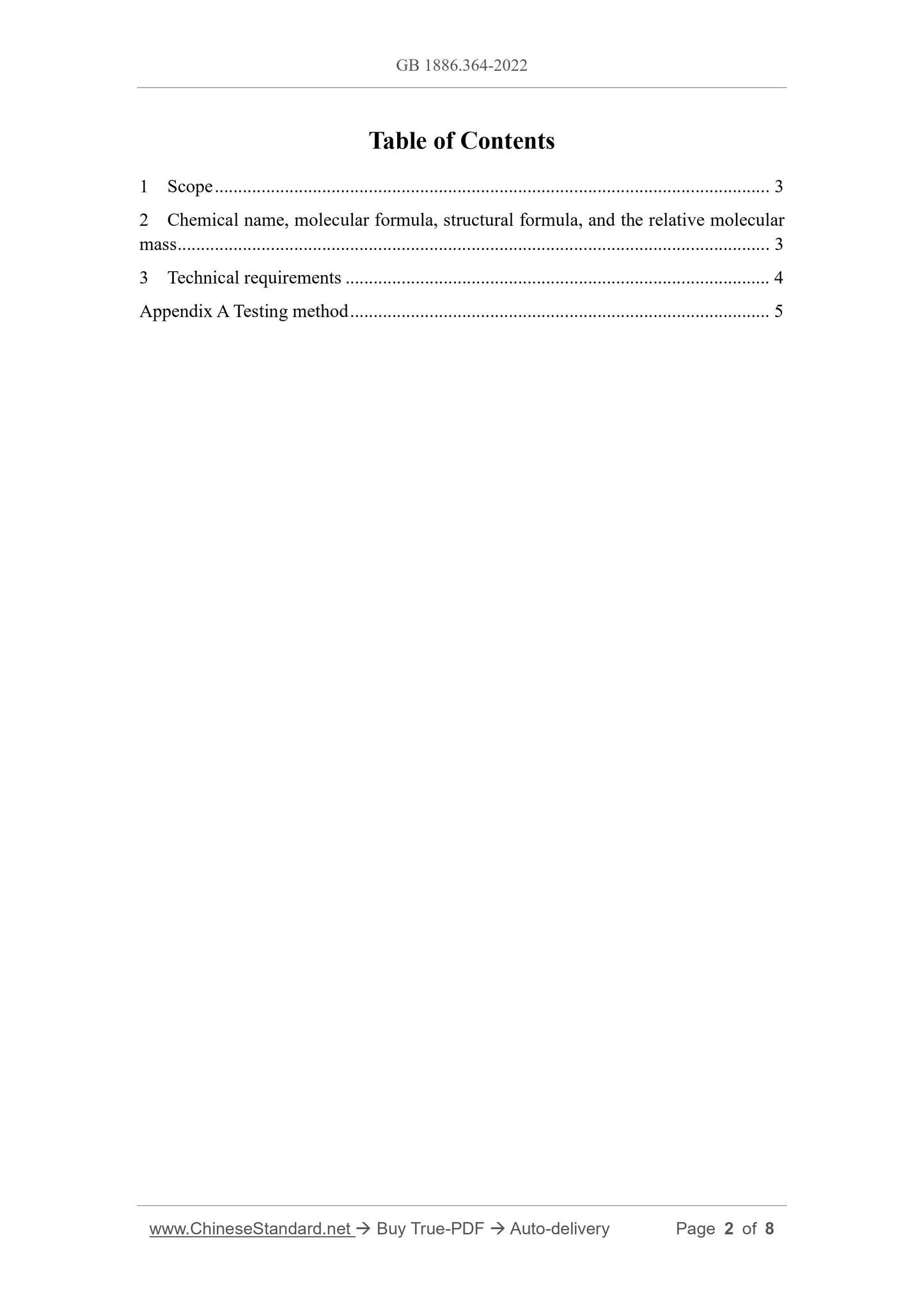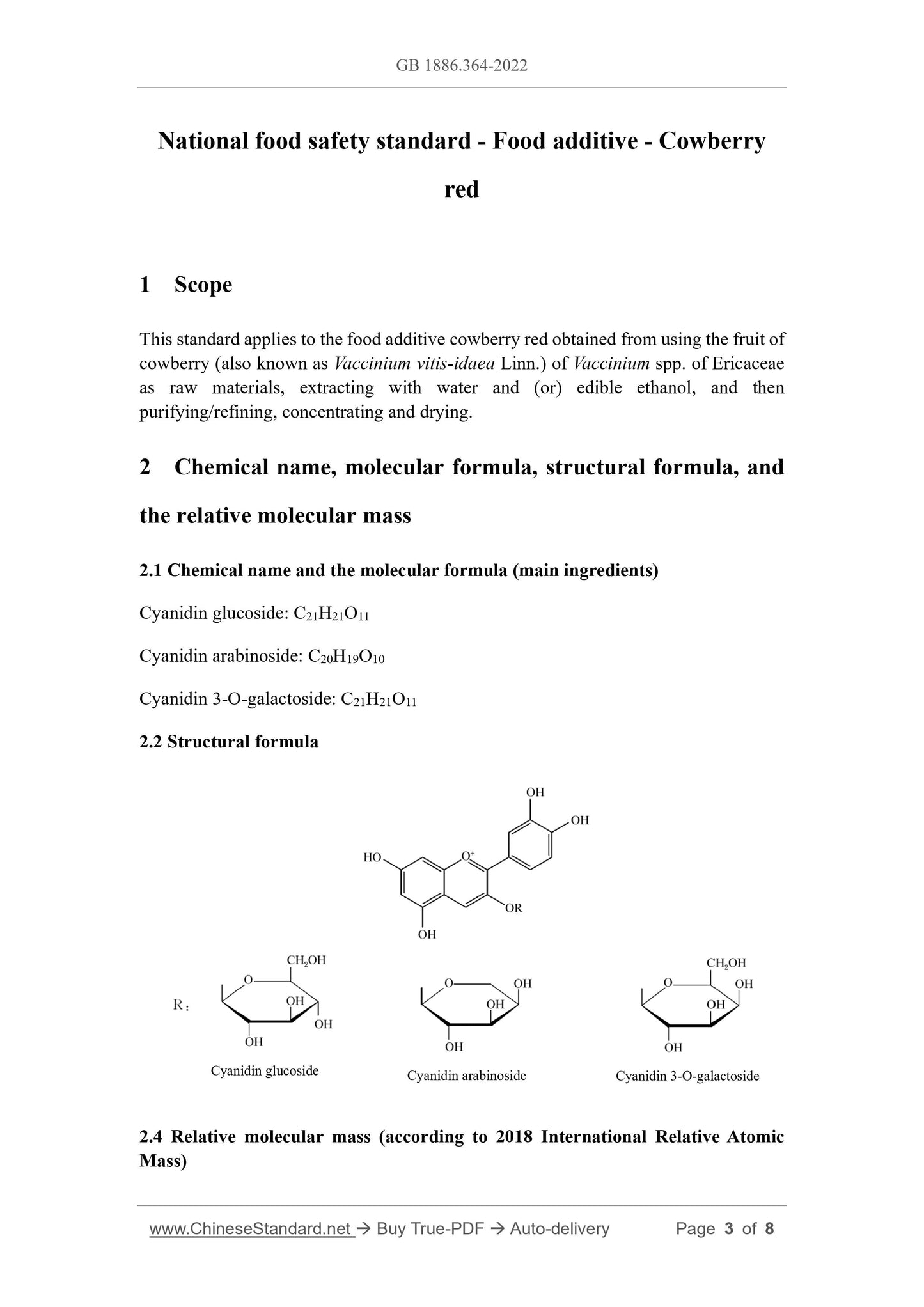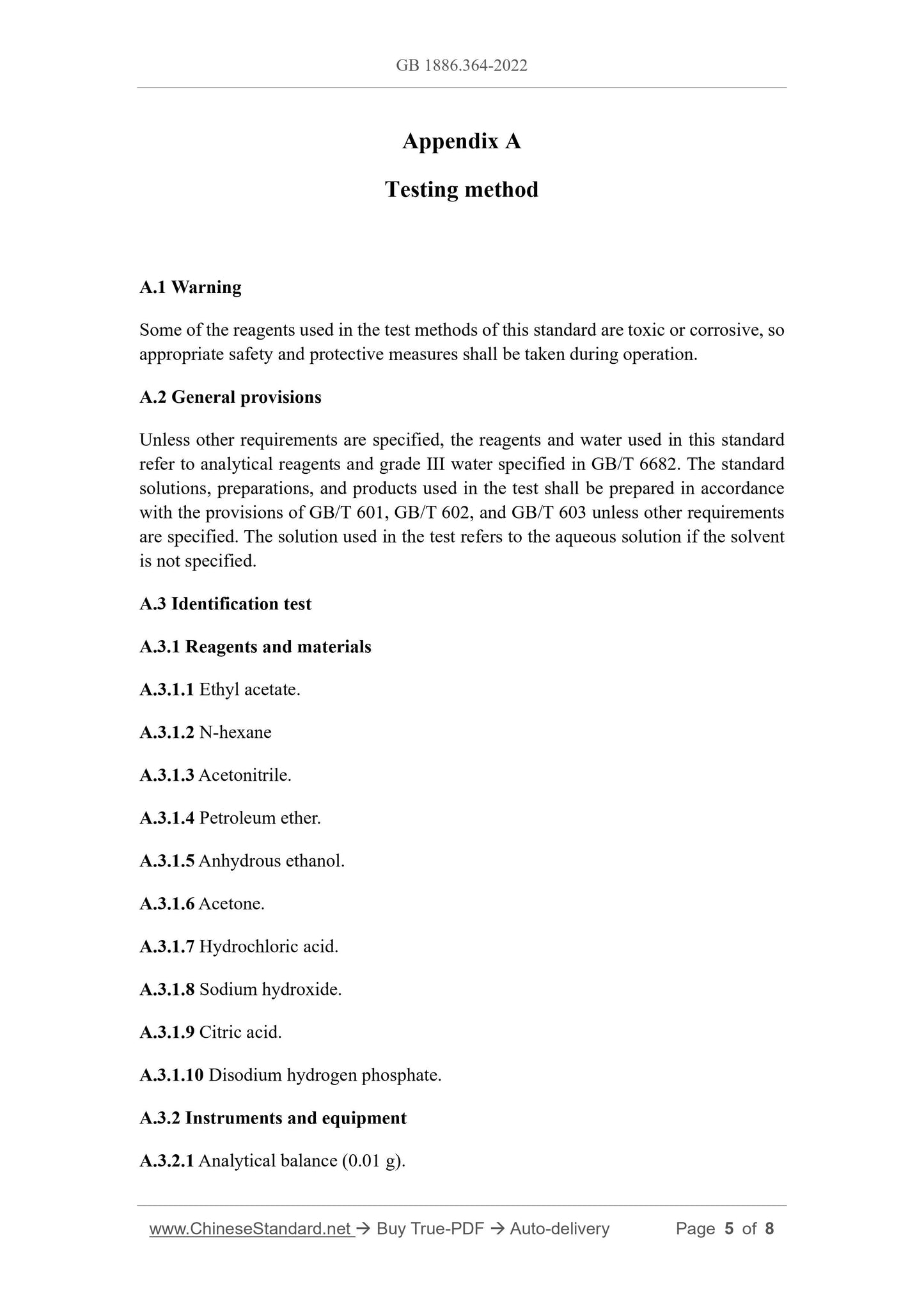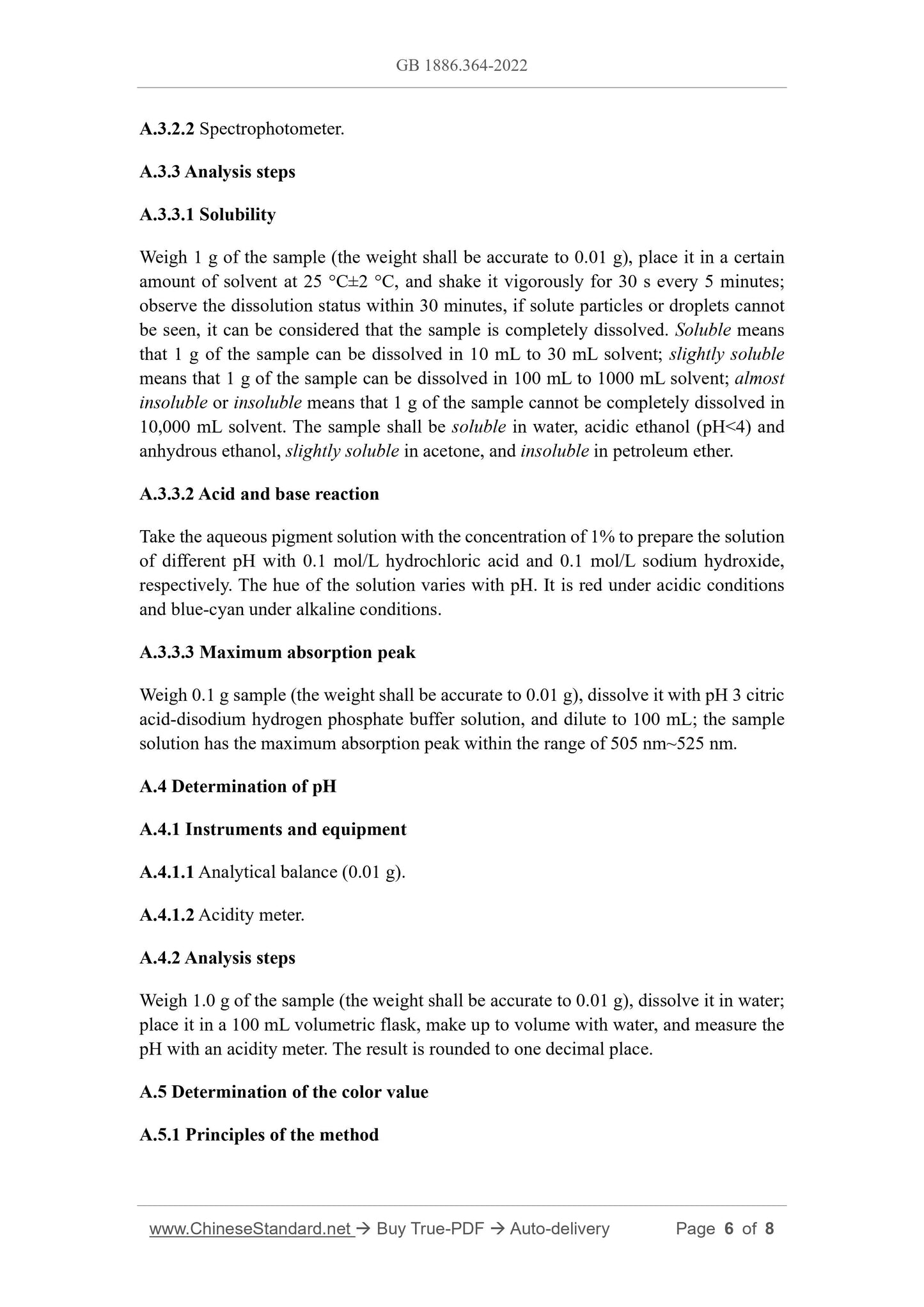1
/
of
5
PayPal, credit cards. Download editable-PDF & invoice In 1 second!
GB 1886.364-2022 English PDF (GB1886.364-2022)
GB 1886.364-2022 English PDF (GB1886.364-2022)
Regular price
$95.00 USD
Regular price
Sale price
$95.00 USD
Unit price
/
per
Shipping calculated at checkout.
Couldn't load pickup availability
Delivery: 3 seconds. Download true-PDF + Invoice.
Get QUOTATION in 1-minute: Click GB 1886.364-2022
Historical versions: GB 1886.364-2022
Preview True-PDF (Reload/Scroll if blank)
GB 1886.364-2022: National food safety standard - Food additive - Cowberry red
GB 1886.364-2022
NATIONAL STANDARD OF THE
PEOPLE’S REPUBLIC OF CHINA
National food safety standard - Food additive - Cowberry
red
食品添加剂 越橘红
ISSUED ON. JUNE 30, 2022
IMPLEMENTED ON. DECEMBER 30, 2022
Issued by. National Health Commission of PRC;
State Administration for Market Regulation.
Table of Contents
1 Scope... 3
2 Chemical name, molecular formula, structural formula, and the relative molecular
mass... 3
3 Technical requirements... 4
Appendix A Testing method... 5
National food safety standard - Food additive - Cowberry
red
1 Scope
This standard applies to the food additive cowberry red obtained from using the fruit of
cowberry (also known as Vaccinium vitis-idaea Linn.) of Vaccinium spp. of Ericaceae
as raw materials, extracting with water and (or) edible ethanol, and then
purifying/refining, concentrating and drying.
2 Chemical name, molecular formula, structural formula, and
the relative molecular mass
2.1 Chemical name and the molecular formula (main ingredients)
Cyanidin glucoside. C21H21O11
Cyanidin arabinoside. C20H19O10
Cyanidin 3-O-galactoside. C21H21O11
2.2 Structural formula
2.4 Relative molecular mass (according to 2018 International Relative Atomic
Mass)
Cyanidin glucoside Cyanidin arabinoside Cyanidin 3-O-galactoside
Appendix A
Testing method
A.1 Warning
Some of the reagents used in the test methods of this standard are toxic or corrosive, so
appropriate safety and protective measures shall be taken during operation.
A.2 General provisions
Unless other requirements are specified, the reagents and water used in this standard
refer to analytical reagents and grade III water specified in GB/T 6682.The standard
solutions, preparations, and products used in the test shall be prepared in accordance
with the provisions of GB/T 601, GB/T 602, and GB/T 603 unless other requirements
are specified. The solution used in the test refers to the aqueous solution if the solvent
is not specified.
A.3 Identification test
A.3.1 Reagents and materials
A.3.1.1 Ethyl acetate.
A.3.1.2 N-hexane
A.3.1.3 Acetonitrile.
A.3.1.4 Petroleum ether.
A.3.1.5 Anhydrous ethanol.
A.3.1.6 Acetone.
A.3.1.7 Hydrochloric acid.
A.3.1.8 Sodium hydroxide.
A.3.1.9 Citric acid.
A.3.1.10 Disodium hydrogen phosphate.
A.3.2 Instruments and equipment
A.3.2.1 Analytical balance (0.01 g).
A.3.2.2 Spectrophotometer.
A.3.3 Analysis steps
A.3.3.1 Solubility
Weigh 1 g of the sample (the weight shall be accurate to 0.01 g), place it in a certain
amount of solvent at 25 °C±2 °C, and shake it vigorously for 30 s every 5 minutes;
observe the dissolution status within 30 minutes, if solute particles or droplets cannot
be seen, it can be considered that the sample is completely dissolved. Soluble means
that 1 g of the sample can be dissolved in 10 mL to 30 mL solvent; slightly soluble
means that 1 g of the sample can be dissolved in 100 mL to 1000 mL solvent; almost
insoluble or insoluble means that 1 g of the sample cannot be completely dissolved in
10,000 mL solvent. The sample shall be soluble in water, acidic ethanol (pH< 4) and
anhydrous ethanol, slightly soluble in acetone, and insoluble in petroleum ether.
A.3.3.2 Acid and base reaction
Take the aqueous pigment solution with the concentration of 1% to prepare the solution
of different pH with 0.1 mol/L hydrochloric acid and 0.1 mol/L sodium hydroxide,
respectively. The hue of the solution varies with pH. It is red under acidic conditions
and blue-cyan under alkaline conditions.
A.3.3.3 Maximum absorption peak
Weigh 0.1 g sample (the weight shall be accurate to 0.01 g), dissolve it with pH 3 citric
acid-disodium hydrogen phosphate buffer solution, and dilute to 100 mL; the sample
solution has the maximum absorption peak within the range of 505 nm~525 nm.
A.4 Determination of pH
A.4.1 Instruments and equipment
A.4.1.1 Analytical balance (0.01 g).
A.4.1.2 Acidity meter.
A.4.2 Analysis steps
Weigh 1.0 g of the sample (the weight shall be accurate to 0.01 g), dissolve it in water;
place it in a 100 mL volumetric flask, make up to volume with water, and measure the
pH with an acidity meter. The result is rounded to one decimal place.
A.5 Determination of the color value
A.5.1 Principles of the method
Get QUOTATION in 1-minute: Click GB 1886.364-2022
Historical versions: GB 1886.364-2022
Preview True-PDF (Reload/Scroll if blank)
GB 1886.364-2022: National food safety standard - Food additive - Cowberry red
GB 1886.364-2022
NATIONAL STANDARD OF THE
PEOPLE’S REPUBLIC OF CHINA
National food safety standard - Food additive - Cowberry
red
食品添加剂 越橘红
ISSUED ON. JUNE 30, 2022
IMPLEMENTED ON. DECEMBER 30, 2022
Issued by. National Health Commission of PRC;
State Administration for Market Regulation.
Table of Contents
1 Scope... 3
2 Chemical name, molecular formula, structural formula, and the relative molecular
mass... 3
3 Technical requirements... 4
Appendix A Testing method... 5
National food safety standard - Food additive - Cowberry
red
1 Scope
This standard applies to the food additive cowberry red obtained from using the fruit of
cowberry (also known as Vaccinium vitis-idaea Linn.) of Vaccinium spp. of Ericaceae
as raw materials, extracting with water and (or) edible ethanol, and then
purifying/refining, concentrating and drying.
2 Chemical name, molecular formula, structural formula, and
the relative molecular mass
2.1 Chemical name and the molecular formula (main ingredients)
Cyanidin glucoside. C21H21O11
Cyanidin arabinoside. C20H19O10
Cyanidin 3-O-galactoside. C21H21O11
2.2 Structural formula
2.4 Relative molecular mass (according to 2018 International Relative Atomic
Mass)
Cyanidin glucoside Cyanidin arabinoside Cyanidin 3-O-galactoside
Appendix A
Testing method
A.1 Warning
Some of the reagents used in the test methods of this standard are toxic or corrosive, so
appropriate safety and protective measures shall be taken during operation.
A.2 General provisions
Unless other requirements are specified, the reagents and water used in this standard
refer to analytical reagents and grade III water specified in GB/T 6682.The standard
solutions, preparations, and products used in the test shall be prepared in accordance
with the provisions of GB/T 601, GB/T 602, and GB/T 603 unless other requirements
are specified. The solution used in the test refers to the aqueous solution if the solvent
is not specified.
A.3 Identification test
A.3.1 Reagents and materials
A.3.1.1 Ethyl acetate.
A.3.1.2 N-hexane
A.3.1.3 Acetonitrile.
A.3.1.4 Petroleum ether.
A.3.1.5 Anhydrous ethanol.
A.3.1.6 Acetone.
A.3.1.7 Hydrochloric acid.
A.3.1.8 Sodium hydroxide.
A.3.1.9 Citric acid.
A.3.1.10 Disodium hydrogen phosphate.
A.3.2 Instruments and equipment
A.3.2.1 Analytical balance (0.01 g).
A.3.2.2 Spectrophotometer.
A.3.3 Analysis steps
A.3.3.1 Solubility
Weigh 1 g of the sample (the weight shall be accurate to 0.01 g), place it in a certain
amount of solvent at 25 °C±2 °C, and shake it vigorously for 30 s every 5 minutes;
observe the dissolution status within 30 minutes, if solute particles or droplets cannot
be seen, it can be considered that the sample is completely dissolved. Soluble means
that 1 g of the sample can be dissolved in 10 mL to 30 mL solvent; slightly soluble
means that 1 g of the sample can be dissolved in 100 mL to 1000 mL solvent; almost
insoluble or insoluble means that 1 g of the sample cannot be completely dissolved in
10,000 mL solvent. The sample shall be soluble in water, acidic ethanol (pH< 4) and
anhydrous ethanol, slightly soluble in acetone, and insoluble in petroleum ether.
A.3.3.2 Acid and base reaction
Take the aqueous pigment solution with the concentration of 1% to prepare the solution
of different pH with 0.1 mol/L hydrochloric acid and 0.1 mol/L sodium hydroxide,
respectively. The hue of the solution varies with pH. It is red under acidic conditions
and blue-cyan under alkaline conditions.
A.3.3.3 Maximum absorption peak
Weigh 0.1 g sample (the weight shall be accurate to 0.01 g), dissolve it with pH 3 citric
acid-disodium hydrogen phosphate buffer solution, and dilute to 100 mL; the sample
solution has the maximum absorption peak within the range of 505 nm~525 nm.
A.4 Determination of pH
A.4.1 Instruments and equipment
A.4.1.1 Analytical balance (0.01 g).
A.4.1.2 Acidity meter.
A.4.2 Analysis steps
Weigh 1.0 g of the sample (the weight shall be accurate to 0.01 g), dissolve it in water;
place it in a 100 mL volumetric flask, make up to volume with water, and measure the
pH with an acidity meter. The result is rounded to one decimal place.
A.5 Determination of the color value
A.5.1 Principles of the method
Share
